Weiss Java Solutions pages
p. i
(front)
Windfall Software, PCA ZzTEX 12.2
�
Publisher Greg Tobin
Executive Editor Michael Hirsch
Editorial Assistant Lindsey Triebel
Marketing Manager Michelle Brown
Marketing Assistant Dana Lopreato
Digital Asset Manager Marianne Groth
Composition Windfall Software, using ZzTEX
Access the latest information about Addison-Wesley titles from our World Wide Web site: http://www.aw-
bc.com/computing
Many of the designations used by manufacturers and sellers to distinguish their products are claimed as
trademarks. Where those designations appear in this book, and Addison-Wesley was aware of a trademark
claim, the designations have been printed in initial caps or all caps.
Copyright © 2007 by Pearson Education, Inc.
For information on obtaining permission for use of material in this work, please submit a written request
to Pearson Education, Inc., Rights and Contract Department, 75 Arlington Street, Suite 300, Boston, MA
02116 or fax your request to (617) 848-7047.
All rights reserved. No part of this publication may be reproduced, stored in a retrieval system, or
transmitted, in any form or by any means, electronic, mechanical, photocopying, recording, or any other
media embodiments now known or hereafter to become known, without the prior written permission of
the publisher. Printed in the United States of America.
1 2 3 4 5 6 7 8 9 10—PDF— 9 08 07 06
Weiss Java Solutions pages
p. ii
(front)
Windfall Software, PCA ZzTEX 12.2
�
C O N T E N T S
Preface
Chapter 1 Introduction
Chapter 2 Algorithm Analysis
Chapter 3 Lists, Stacks, and Queues
Chapter 4 Trees
Chapter 5 Hashing
Chapter 6 Priority Queues (Heaps)
Chapter 7 Sorting
Chapter 8 The Disjoint Set Class
Chapter 9 Graph Algorithms
Chapter 10 Algorithm Design Techniques
Chapter 11 Amortized Analysis
Chapter 12 Advanced Data Structures and Implementation
v
1
3
7
29
47
53
61
67
71
85
95
99
Weiss Java Solutions pages
p. iii
(front)
iii
Windfall Software, PCA ZzTEX 12.2
�
Weiss Java Solutions pages
p. iv (front)
Windfall Software, PCA ZzTEX 12.2
�
P R E F A C E
Included in this manual are answers to many of the exercises in the textbook Data Structures and
Algorithm Analysis in Java, second edition, published by Addison-Wesley. These answers reflect the
state of the book in the first printing of the second edition.
Specifically omitted are general programming questions and any question whose solution is
pointed to by a reference at the end of the chapter. Solutions vary in degree of completeness; generally,
minor details are left to the reader. For clarity, the few code segments that are present are meant to
be pseudo-Java rather than completely perfect code.
Errors can be reported to weiss@fiu.edu.
Weiss Java Solutions pages
p. v (front)
v
Windfall Software, PCA ZzTEX 12.2
�
Weiss Java Solutions pages
p. vi
(front)
Windfall Software, PCA ZzTEX 12.2
�
C H A P T E R 1
Introduction
1.4
The general way to do this is to write a procedure with heading
void processFile( String fileName );
which opens fileName, does whatever processing is needed, and then closes it. If a line of the form
#include SomeFile
is detected, then the call
processFile( SomeFile );
is made recursively. Self-referential includes can be detected by keeping a list of files for which a call
to processFile has not yet terminated, and checking this list before making a new call to processFile.
1.5
1.7
1.8
1.9
1.10
public static int ones( int n )
{
if( n < 2 )
return n;
return n % 2 + ones( n / 2 );
}
42
4
43
+ 3
+ 2
+ 9
42
(a) The proof is by induction. The theorem is clearly true for 0 < X ≤ 1, since it is true for X = 1,
and for X < 1, log X is negative. It is also easy to see that the theorem holds for 1 < X ≤ 2, since
it is true for X = 2, and for X < 2, log X is at most 1. Suppose the theorem is true for p < X ≤ 2p
(where p is a positive integer), and consider any 2p < Y ≤ 4p (p ≥ 1). Then log Y = 1+ log(Y /2) <
1+ Y /2 < Y /2 + Y /2 ≤ Y, where the first inequality follows by the inductive hypothesis.
B = 2XB. Thus log AB = XB. Since X = log A, the theorem is proved.
(b) Let 2X = A. Then AB = (2X)
(a) The sum is 4/3 and follows directly from the formula.
+ 2
(b) S = 1
gives 3S = 1+ 1
(c) S = 1
+ 4
second gives 3S = 1+ 3
2(4/9) + 4/3 = 20/9. Thus S = 20/27.
(d) Let SN
N
− N/2−1
of SN−1, SN−2, . . . , S0 and solve the recurrence. Solving the recurrence is very difficult.
i=1
i=N/2
24 = 16 ≡ 1 (mod 5). (24)
+ . . .. Subtracting the first equation from the second
+ . . .. Subtracting the first equation from the
+ 16
4i . Thus 3S =
iN
4i . Follow the same method as in parts (a)–(c) to obtain a formula for SN in terms
25 ≡ 125 (mod 5). Thus 2100 ≡ 1 (mod 5).
+ 3
+ . . .. 4S = 1+ 2
+ . . .. By part (a), 3S = 4/3 so S = 4/9.
+ . . .. 4S = 1+ 4
+ 9
+ . . .. Rewriting, we get 3S = 2
= ∞
= N
i=0
≈ ln N − ln N/2 ≈ ln 2.
∞
i=0
+ ∞
i=0
+ 5
42
+ 7
43
i=1
42
43
4
42
4
4
4
42
43
1
i
1
i
i
4i
1
4
1
i
Weiss Java Solutions pages
p. 1 (chap01)
Windfall Software, PCA ZzTEX 12.2
1
�
Introduction
Chapter 1
(a) Proof is by induction. The statement is clearly true for N = 1 and N = 2. Assume true for
+ Fk+1. By the induction hypothesis, the value of the sum
N = 1, 2, . . . , k. Then
− 2, where the latter equality follows from the definition of
on the right is Fk+2
the Fibonacci numbers. This proves the claim for N = k + 1, and hence for all N.
(b) As in the text, the proof is by induction. Observe that φ + 1= φ2. This implies that φ
−1+ φ
−2 =
1. For N = 1 and N = 2, the statement is true. Assume the claim is true for N = 1, 2, . . . , k.
= k
Fi
Fi
i=1
= Fk+3
− 2 + Fk+1
k+1
i=1
= Fk
+ Fk−1
Fk+1
by the definition, and we can use the inductive hypothesis on the right-hand side, obtaining
Fk+1 < φk + φk−1
−1φk+1 + φ
−1 + φ
< φ
Fk+1 < (φ
−2φk+1
−2)φk+1 < φk+1
and proving the theorem.
(c) See any of the advanced math references at the end of the chapter. The derivation involves the
use of generating functions.
2
1.11
1.12
N
i=1
(2i − 1) = 2
i − N
N
i=1
(a)
(b) The easiest way to prove this is by induction. The case N = 1 is trivial. Otherwise,
i=1
4
i3
i=1
1= N(N + 1) − N = N2.
i3 = (N + 1)3 + N
N+1
i=1
= (N + 1)3 + N2(N + 1)2
+ (N + 1)
= (N + 1)2
N2
4
N2 + 4N + 4
= (N + 1)2
= (N + 1)2(N + 2)2
(N + 1)(N + 2)
=
N+1
i=1
=
22
2
2
4
2
i
Weiss Java Solutions pages
p. 2 (chap01)
Windfall Software, PCA ZzTEX 12.2
�
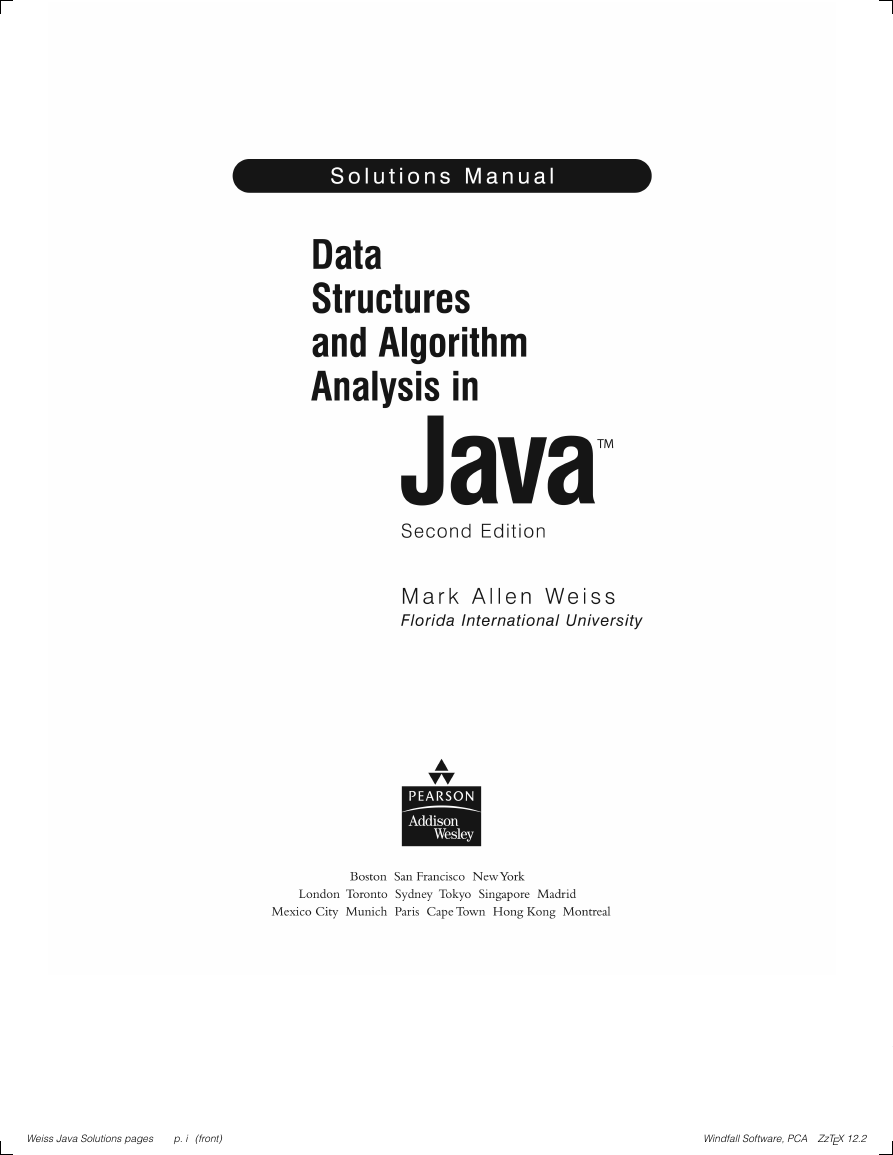
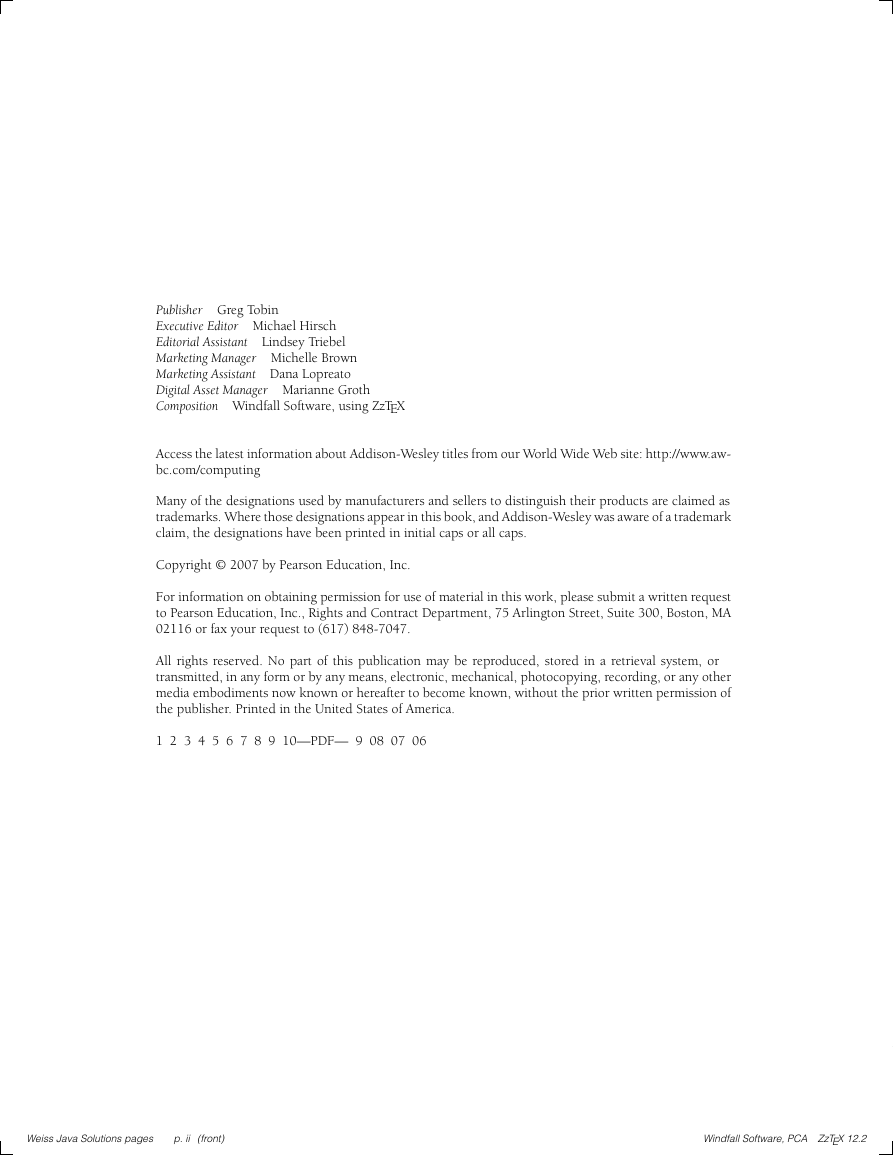


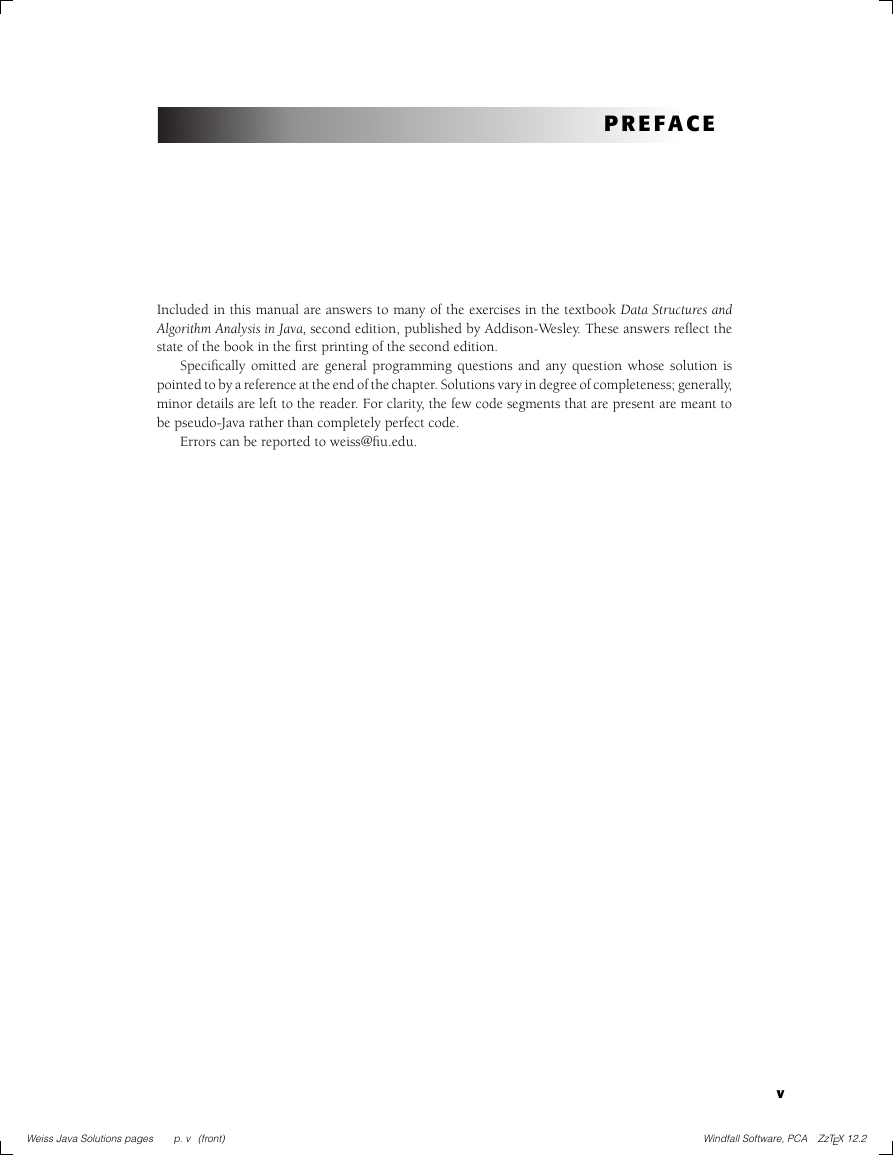

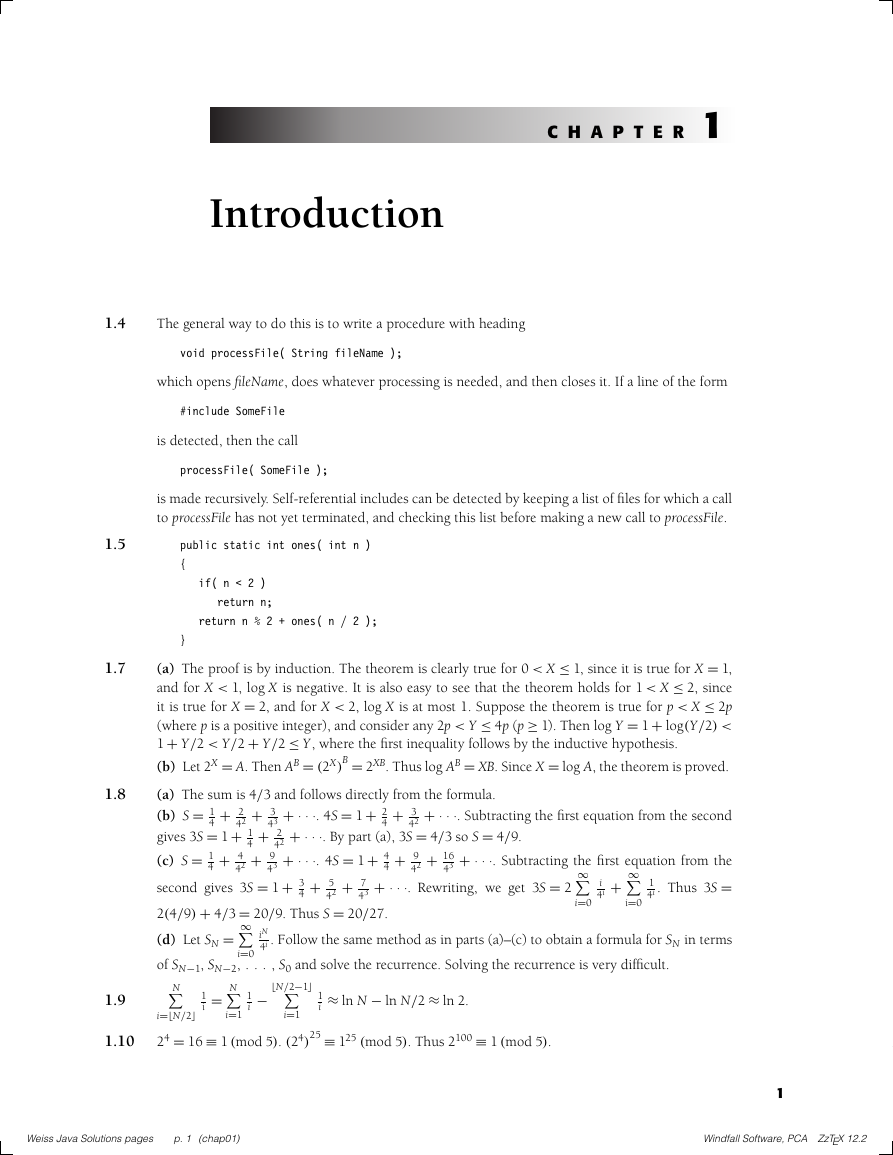
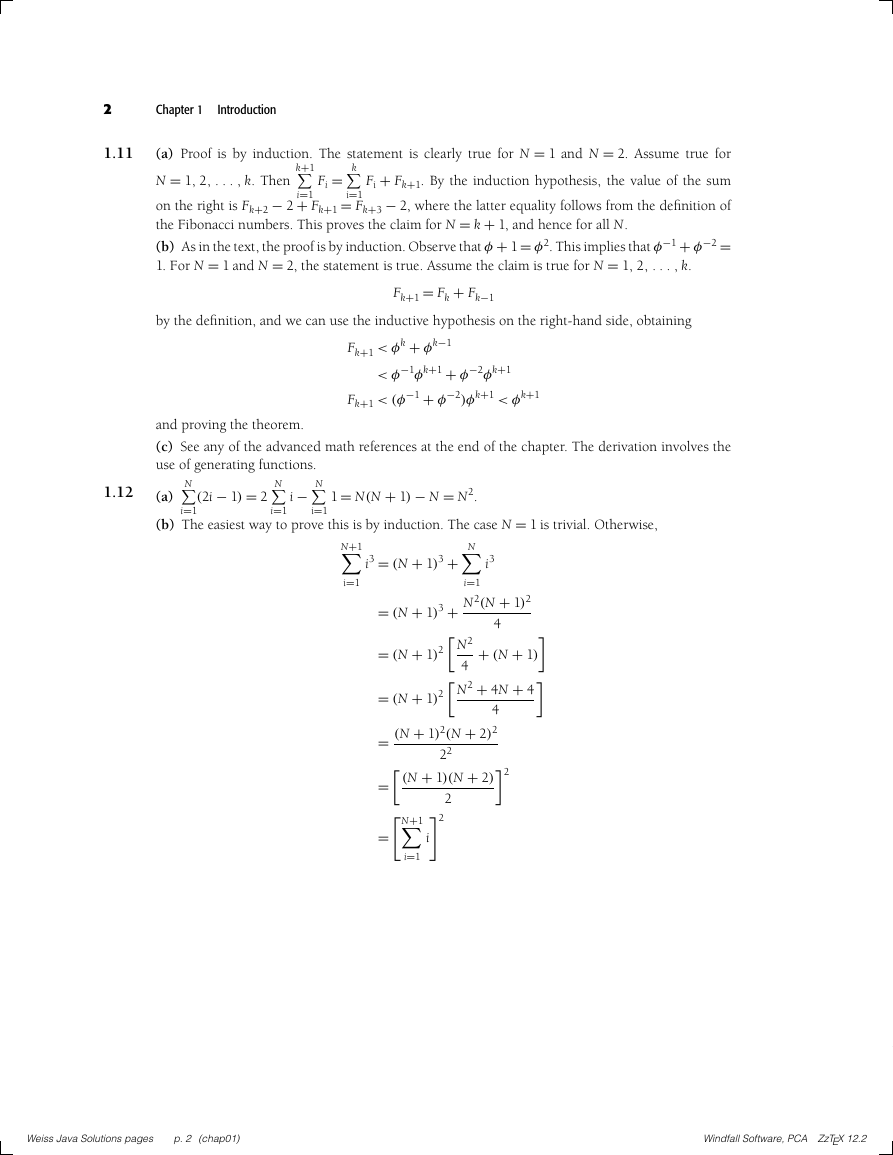








 2023年江西萍乡中考道德与法治真题及答案.doc
2023年江西萍乡中考道德与法治真题及答案.doc 2012年重庆南川中考生物真题及答案.doc
2012年重庆南川中考生物真题及答案.doc 2013年江西师范大学地理学综合及文艺理论基础考研真题.doc
2013年江西师范大学地理学综合及文艺理论基础考研真题.doc 2020年四川甘孜小升初语文真题及答案I卷.doc
2020年四川甘孜小升初语文真题及答案I卷.doc 2020年注册岩土工程师专业基础考试真题及答案.doc
2020年注册岩土工程师专业基础考试真题及答案.doc 2023-2024学年福建省厦门市九年级上学期数学月考试题及答案.doc
2023-2024学年福建省厦门市九年级上学期数学月考试题及答案.doc 2021-2022学年辽宁省沈阳市大东区九年级上学期语文期末试题及答案.doc
2021-2022学年辽宁省沈阳市大东区九年级上学期语文期末试题及答案.doc 2022-2023学年北京东城区初三第一学期物理期末试卷及答案.doc
2022-2023学年北京东城区初三第一学期物理期末试卷及答案.doc 2018上半年江西教师资格初中地理学科知识与教学能力真题及答案.doc
2018上半年江西教师资格初中地理学科知识与教学能力真题及答案.doc 2012年河北国家公务员申论考试真题及答案-省级.doc
2012年河北国家公务员申论考试真题及答案-省级.doc 2020-2021学年江苏省扬州市江都区邵樊片九年级上学期数学第一次质量检测试题及答案.doc
2020-2021学年江苏省扬州市江都区邵樊片九年级上学期数学第一次质量检测试题及答案.doc 2022下半年黑龙江教师资格证中学综合素质真题及答案.doc
2022下半年黑龙江教师资格证中学综合素质真题及答案.doc